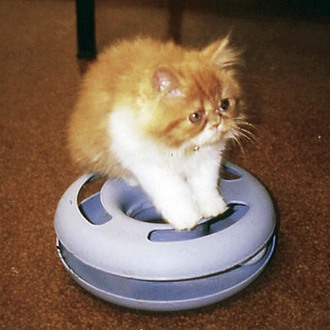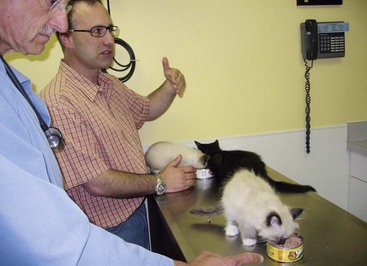CHAPTER 11 Kitten Socialization and Training Classes
It is now well accepted that puppies benefit from attending socialization and training classes. So if puppies can attend school, why not kittens? There are many positive outcomes when kittens and people attend kitten socialization classes, which were first developed in Australia as Kitten Kindy.13
The idea of training cats, let alone holding kitten socialization and training classes, is a foreign concept to most people.13 However, kitten classes can be just as successful and deliver many of the same benefits to owners, kittens, and the veterinary practice as puppy classes (Box 11-1). Kitten classes are designed to be an early socialization, training, and education program to help owners and kittens start off on the right track. Kitten classes aim to help prevent behavioral problems, as well as educate owners on all aspects of raising a kitten and then living with a cat in the family. The aim is also to establish a close bond among the cat, the owner, and the veterinary practice. It is yet another valuable service that veterinarians should offer their patients and clients.
BOX 11-1 The Value of Kitten Socialization Classes
• All kittens are examined before attending, which requires establishing a relationship with a veterinarian.
• Kittens are desensitized to the carrier.
• Kittens are habituated to travel.
• Kittens are habituated to unfamiliar people.
• Owners learn about proper care, which enhances cat health: nail clipping, brushing the coat, and brushing teeth.
• Owners who have a stronger bond with their cats may be more likely to note subtle signs of illness and visit the veterinarian proactively for wellness exams.
• Many behavioral problems can be prevented.
• The class provides a veterinary resource for behavior-related problems.
• The instructor can provide information on feline heartworm prevention and what to do to control fleas and ticks (where applicable).
• The class helps to dispel common myths about cats (e.g., cats are antisocial).
• Owners learn that they can exercise their cats and provide an interesting enriched life indoors. They also discover that cats can learn and be trained.
• The class boosts the confidence of kittens and owners alike, and the sessions are fun for kittens, owners, and instructors.
Although the issue has not been formally studied, kitten classes are likely to save lives, insofar as some of the recognized potential risk factors for relinquishment could be addressed in well-run kitten classes. These risk factors include harboring unrealistic or inappropriate expectations about the cat’s role in the household, allowing the cat outdoors, owning a sexually intact cat, and never having read a book about cat behavior; cats that eliminate inappropriately on a daily or weekly basis are also at risk.11 The most frequent explanations for surrender are behavioral problems—problems that might have been prevented.9,10
Most veterinary behaviorists now believe that kitten socialization classes (when properly taught) are beneficial,9,10,12 and kitten socialization classes are suggested in the American Association of Feline Practitioners Feline Behavior Guidelines.10
On average, cats visit the veterinarian less than half as often as dogs,7 yet cats outnumber dogs by approximately 20%.1 Given that most socialization classes require a sign-off form from the veterinarian, enrollment in such a class ensures at least one veterinary visit and so establishes a relationship with a veterinarian.10
Getting Started
Planning Classes
• Inform owners about normal feline behavior.
• Allow kittens to socialize in a safe and controlled environment.
• Teach kittens to accept gentle handling from humans.
• Habituate kittens to a variety of stimuli so that they grow into manageable, easily handled adult cats.
• Identify problem behaviors, and provide possible solutions to common issues such as litter training, biting, and scratching.
• Provide advice on how to modify unacceptable behavior, and refer to a veterinary behaviorist if necessary.
• Help owners to have realistic expectations for their pet.
• Help owners build a strong bond with the veterinary practice.
• Educate owners on all aspects of kitten development, pet care, and living with a cat in the family—fostering socially responsible pet ownership.
Equipment
The following items can be used and demonstrated in kitten kindergarten class:
• Cat-safe collars, harnesses, and leashes
• Clickers (if the instructor wants to demonstrate their use)
• Several different types of scratching posts (vertical and horizontal)
• Assortment of cat carriers: top opening, front opening, and so forth, so that the advantages and disadvantages of each can be explained
• Selection of litter boxes (e.g., covered, uncovered, liners) so that the advantages and disadvantages of each can be explained. (Standard litter boxes or inexpensive disposable cardboard litter boxes should always be available for kittens to use during class. These should be disposed of and replaced or disinfected after each class.)
• An indoor garden with samples of cat grass, catnip, and other kitten-safe greens so that the instructors can explain which plants are suitable and the potential hazards of certain toxic house plants

FIGURE 11-1 Track-type toys have a ball inside a box or circular plastic cylinder and are popular with kittens.
Location
As previously mentioned, the veterinary clinic is the ideal location for the classes because the aim is to familiarize the kitten and the owner with the practice and its staff (Figure 11-2). Although other locations allow kittens to socialize and owners to be educated about cats, these places do not allow optimal familiarization with the veterinary practice or its staff.
Stay updated, free articles. Join our Telegram channel

Full access? Get Clinical Tree



